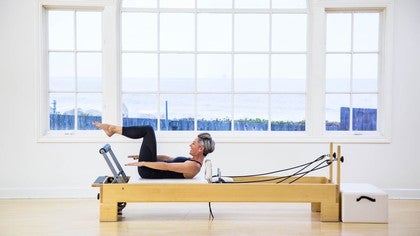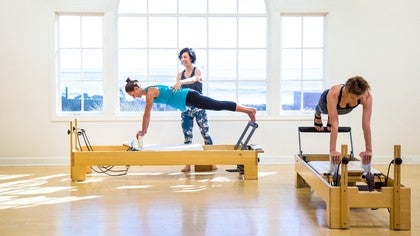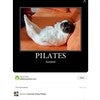Description
About This Video
Transcript
Read Full Transcript
What I'm gonna give to you today are my favorite exercises put together in a way that really mobilize your whole body and will make you feel great and will help you to recover more efficiently. So we're gonna begin though by getting warmed up a little bit because your muscles and your joints work a lot better when they're warmer. So we're gonna help them along by doing some footwork. I'm gonna come down onto the carriage, and I'm gonna to take my feet and place them on the footbar, and we're just gonna do our toes apart, heels together. Our first position here.
I'm using three regular springs on the Balanced Body Reformer and I actually have one light spring on, one blue spring. So from here, I'm just gonna press out and come back in. This isn't about going fast today. This is really about working through that range of motion. As I'm pressing out, I'm pressing in.
The breath is flowing and I'm keeping my pelvis level, meaning my hip bones and my pubic bone are level with each other. That creates a little space between your lumbar spine and the carriage, and it helps with that neutral alignment to help keep everything where it should be. You're gonna exhale through pursed lips to help you engage the deep core muscles in the pelvis, around the pelvis and the lumbar spine and you're gonna inhale through the nose. Here, if you wanna inhale on the way out and exhale to return. That feels really good.
You can switch that breath if you're not able to stabilize as you press out. Then we're just gonna take the legs, bring them together, wrap the toes over the bar, and keeping the heels still in space we're gonna press out from there. The abdominals just stay engaged and just feel those joints and muscles in the lower body warming up. Exhale. Inhale away.
Exhale to come back in. Let's just do that a couple more times. Reaching through and returning. Now I'm just gonna take the heels, place those on the bar, and same thing and pushing out. Now we know working from the heel here is a better way to get into those posterior muscles, so that's what I want you to focus on as you exhale and push out, inhale and return, keeping that alignment through the spine.
Then we're just gonna change our foot position again. High half-toe. So this is on the ball of your feet, your plantar flex, You're pressing out and keeping the heel still in space. Same breathing. You can inhale on the way out or exhale on the way out.
Just keep it flowing. Then two more. And one more. Now on this last one, we're gonna stay here, and we're just gonna do a lower and lift. So reach the heels under and lift them up.
Down and up. Nice and slow. You're going for the stretch here. Two more. One more.
And then I'm actually gonna go into a little running, so one heel will reach under, the other heel will lift up as that knee bends and you're really just working through the foot and ankle here, articulating through. This is really great if you do a lot of running, or you do a lot of high intensity leg work, plyometrics and stuff. This is so great to help recovery. Just big range of motion and working through. 6Then up and come all the way back in.
Now second position, you're just gonna take your feet and legs out, turn your legs out, knees following the line of your toes and same thing. You can inhale on the way out, if you feel comfortable with that or you can switch that breath if you want. Just reaching through. It's good to work the legs in all different positions here. Two more times.
And one more time, pressing away and returning. Now I'm gonna change my springs here because I'm gonna go into some, I'm gonna call it a hundreds, but it's not really the hundreds, we're just doing a variation of it. I call it the hundreds tuck. So I'm just going down and I'm actually only gonna use one regular spring. One red spring, because I don't want a lot of tension here.
Again, this is about kind of warming up and mobilizing. It's not about putting the muscles through a lot of work. So when I come down onto the carriage, I'm gonna take the straps in my hands, and I'm gonna scoot myself a little bit away from the shoulder rest there and I'm gonna start with my elbows bent. Now for this one, I'm actually gonna start with my legs lengthened when I'm ready to begin and I'm gonna inhale. Then as I exhale I'm gonna straighten my elbows, bend my knees and come into a tuck, and then come all the way back out.
Again exhale, come into my tuck, I'm even lifting my bum up and then come all the way back out. Using that resistance, just that light resistance, something to press against, will help you get more into the tuck with your body. If you notice, I'm immediately rotating my arms, turning them in to help me get more thoracic flex. One more. Tuck.
And then out. Now I'm gonna place my feet there. Actually the straps are gonna go on my feet but I need to change my resistance a little bit here. So I'm gonna be using two red springs here. Two of the regular springs and I'm coming back down.
I'm taking the straps and placing them on my feet. This is my favorite thing to do in recovery is feet in straps work. So I'm gonna start just with a simple bend and stretch. Bending and breathing in. Exhale and pressing out.
I'm gonna begin here really focusing on not allowing the pelvis to tip back as I bend my knees in toward me, so try to maintain that little neutral alignment of the lumbar spine. Now I'm gonna do that same thing in lateral rotation. Really the goal here is to mobilize all of the muscle fibers in every direction that we can. So sometimes parallel. Sometimes lateral rotation and then I'm just gonna go into my lift and lower parallel.
As my legs go up, I think opposition. I kinda sink the tailbone down. Don't let the pull happen from behind the knees, rather make it happen from behind the glutes. I'm gonna just do that same thing. I'm gonna turn my legs out here.
You're gonna feel the stretch come up the lateral portion of the hamstring here. Ah, feels so good. Now I'm gonna turn back to parallel. This is one of my favorites. Adductor stretch.
This is so good. You do two out and in. And then come back down. So if you do a lot of cycling. A lot of running, a lot of plyometric work, dancing.
This is such a good stretch. You wanna keep it controlled. You wanna keep it active, so as you're reaching out, you're not just letting your legs flop. You're actually sending energy out through the toes. One more time.
Sinking that tailbone down. Reaching through the legs. Out and in and down. Now I'm gonna take the headrest and lower it into the flat position 'cause what I'm gonna do is bend my knees and I'm gonna roll back. This is a really beautiful lumbar spine stretch.
Inhale to bend. Exhale. Let the springs help, but control the movement as you roll back. And then come back down. One more time like that.
Rolling back into it and come back down. I do wanna dock the carriage, so as I bend my knees and roll back I wanna fell the carriage dock. Then from here I'm gonna lengthen the knees. That'll increase the neural stretch. Bend the knees, roll down and press back out.
Let's do that again. Rolling back, send the legs up, bend the knees and then roll back down. Now I'm gonna add to this. So I'm gonna bend the knees and roll back, so it's all progression. Now from here, I start to draw the tailbone down.
You're gonna feel that increase in the stretch here. Then once I get my hips down, I'm gonna let the legs open and I'm gonna pull around, it takes some of the pressure off the back and it actually helps to open up the hip joint. So let's do that again. Inhale bend the knees. Exhale roll back.
Inhale stretch the legs. Exhale roll down, open the legs, an oval. So don't take the legs as wide as you can. Think about just wider than shoulders. Parallel bend the knees and roll back.
Exhale. Inhale to lengthen. Exhale. Roll down with your legs together. Then when you're almost down, do that oval with the legs and circle them all the way around.
That feels just so good on the back of the thigh. Now I'm gonna bend the knees and we're gonna actually... One more thing. Put your headrest back up. I almost forgot this one and it's a really good one for people who have tight hamstrings.
Like me. So you're gonna bend one knee. You're gonna take the other leg up. So it's kinda like pas de chat or stag, but in parallel. Then you're just gonna reach up and you're gonna draw down.
Not back, but down on that strap. Let your foot stretch and try to anchor the tailbone down. Then release the tension on that and press back out. So it's called walking on the ceiling. If you're looking at your feet, it looks like you're walking on the ceiling.
So you reach up. You take that hand and draw down. Remember you're not pulling backward. It's not about getting that torque in. It's just about syncing the hip on that side.
Then let go as you reach away. Inhale to come up. Exhale, get that stretch. Feels so good. Inhale to let go and then press out.
Other side. Up and sync, release and press it away. Then you can bend your knees, and then you come all the way in here. Return the carriage and come up. Now we're gonna move on.
We're gonna lower the headrest down. So that's a lot of leg mobility that we just did. Let's get a little spine mobility in there. I'm gonna go down in spring on this one. I'm actually gonna go down and take the springs to just one regular.
One red. For this one, depending on the mobility of the hip joint of the person you're working with, or if it's you, if you've got tight hips, you can keep your legs apart on this one like so and sit up on something if you need to. If you can sit with your legs out in front of you and sit pretty much into neutral, you can fold your legs in front of you as well. What we're gonna do first, is just a little flexion and extension here. I like it better when you cross the ropes because it hits right in between the mid traps and rhomboids with this angle.
You're gonna just allow your body to flex forward. If you find that you're hitting the carriage too soon, we're not rolling back, so you can actually scoot all the way back to the end of the carriage on this one. Then you're gonna unravel and lengthen up. You're just gonna lift the sternum up. Now this isn't about the arm pulls.
A lot of times you'll see, or you'll wanna just pull your arms back, and I don't want you to think about doing that. What I want you to think about is moving from the shoulders. The shoulders are forward here. You're gonna start to draw the shoulders back. Just let the elbows soften as you bring the shoulder blades toward each other and lift your sternum up.
That's gonna give you a really good connection in the back and a really nice stretch in the front wall of the spine. Then come forward and let the shoulder blades get pulled apart. Again pulling back, shoulders open. Big breath in and then exhale forward. Let's do that one more time.
Pulling back. Lengthen up. It's a light spring. You just want a little bit of muscular engagement to help you stretch the muscles in the front of the body. And then forward.
Now we are rolling back, so I'm gonna uncross the ropes and now I'm gonna scoot way forward here and I'm gonna end up with my feet just on the edge of the headrest there and I want a lot of room behind me. We're gonna test the waters here. I'm gonna hold onto these straps, and I'm just gonna do like on the Cadillac, you're gonna do a roll down. So you're gonna hold onto the straps, drop your elbows toward the carriage, and just roll back here. When you're laying down on the carriage, if you've got longer hair, not like me, but some people have longer hair, you want to tie it up because you don't want it to get caught in the springs down there.
When you come down you want to feel that you're shoulder blades are right on the edge of the carriage. Then let the springs help you come back up. To roll down, your elbows come down. This is really key so that you can roll through the spine. When you come up, you flex your spine, and then you lift your elbows up.
So instead of thinking biceps, think elbows. So the elbows come down and you're gonna roll on down. This should feel really good. A nice roll through the spine. When you come up, you drop your chin, and you lift the elbows up to come back up to the top.
Now let's progress this. You're gonna come down. You're gonna roll on down. Then you're gonna let your back extend over the end of the carriage. Notice I'm reaching my arms toward the ceiling rather than trying to put them back behind me.
Then just bend and lift the arms to come up. Keep the breath flowing. Don't hold your breath. Exhale. And inhale.
Exhale. And inhale. One more time. Exhale. Lower the elbows.
That helps. Inhale. Reach toward the ceiling with your hands. Exhale. Drop your chin.
Inhale. Lift the elbows. Now you're just gonna take one of those straps and put it down. You're gonna turn to the side here and we're gonna just lay down on the carriage. For this one, I wanna actually use a really light spring.
So I'm just gonna use probably the lightest spring which is gonna be my yellow one. I'm gonna come down onto my side here and I'm actually , I'm sitting against the shoulder rest with my bum. That's really important, so you have enough room going this way. My legs are just folded over the front of the shoulder rest. Take my head.
Rest it in my hand with my arm resting on the carriage, just like this. Just try to get your spine as straight as possible. Super light spring. All I'm gonna do is reach my arm forward. I'm gonna start to reach it up over my head.
I'm gonna rotate, turn the ribs toward the ceiling and then come all the way around. It feels wonderful. So inhale up. Now exhale. Let your ribs rotate.
Don't just turn your arm. Get your whole body to rotate back and then come all the way back around to the front. Let's do that again. Reach up and open. Stretch open there.
Press into that strap to get that really good traction going and then come all the way around. Let's do that on the other side, so you're gonna come on up and we're gonna come over to the other side. Light spring. Hold the strap in front. Scoot back here.
Sit right against the shoulder rest. Hold your legs over it and then come down onto the carriage, resting your head in your arm. So really light spring here. It's not about how much resistance you have. Reach up.
You're pressing your hand into that strap, the whole time here, turning your rib cage, reaching back, stretching, stretching, stretching and then coming around. You're making the absolute biggest circle you can with your entire body, so you're using that rotation of the rib cage to help you get that arm further back, and your head follows the line of the spine. Reach back. Last one, breath in. Exhale here.
Then come all the way back around. Feels really good. It's a really beautiful shoulder and rotation stretch of the spine. Now I'm gonna keep that same light spring on and I'm just gonna face the front here. It's kinda like a dog working it's way around the mat, wasn't it. (laughs) I could've just turned the other way.
It would've been a lot easier. Why make things easy though? What I'm gonna do is hold onto the strap with my outside hand. I have my elbow really close to my side here. I'm just gonna open it out and come back in.
So one of the things most of us need is external rotation. So this, with really light resistance, is triggering my really deep rotators of the shoulder, my rotator cuff muscles, to kick in here. The big ones aren't overtaking it and those are getting a really nice mobility here while my internal rotators are getting a decent stretch. Two more and one more time. Same thing, one of the muscles that we wanna work on in our rotator cuff, it's a great thing to do on your recovery day, is your supraspinatus.
It's right up here and it's deep. Kinda goes over the top cuff of the shoulder. It works the first 10 degrees of abduction and then your delts take over. So really you just need from here to about there, but we're gonna go a little higher here just for mobility. You wanna see if you're feeling your scapula, it should be flat against the rib cage as you do this for good movement.
Yeah? Yeah. Let's just do that same thing on the other side. I'm gonna turn around here and I'm gonna use the front strap in the outside hand. Sitting tall and then with that light spring and a nice strong wrist position. Just a little bit of shoulder mobility.
Open and back. Try not to let the elbow flare away from the body. Keep it kind tight into the body. Not pressed against the body, but just a couple of inches from the body the whole time. Then we'll go right from here into the abduction.
So this is about your elbow, not about your hand. So keep the hand right next to your belly the whole time. That's it. Bring the elbow slightly back as you do this. Just exhale out and inhale back.
Beautiful. One more and back. Now I'm gonna turn around and we're gonna get just a little shoulder mobility. Again, this is really a light spring 'cause it's really just about mobilization. So I'm gonna start here and we want just a little bit of tension on there.
I'm gonna reach up and then come right down. I'm gonna reach right up and come back down. Then I'm gonna add. So I'm gonna reach up and I'm gonna stretch right over and come back down. When I'm doing this and pressing and stretching over and reaching into that strap it's getting me that lateral flexion and working against a tiny bit of resistance so I can go a little bit further than I normally would.
Press right over and reach and back. Alright. Let's do that same thing on the other side. This is really good for helping to increase the range of motion at the shoulder. So holding it right here.
I'm gonna reach it up and stretch right over. Right overhead, press it and reach into it and then come back and two more. Reach right over and come back. This hand is just kinda resting here. No weight.
Last one. Reach over. Stretch, and then come all the way back down. Alright. From there we're gonna move on and we're gonna do a little bit more leg work here, so what I'm gonna do is bring the bar back.
I'm gonna go up in spring a little bit, so I'm just gonna use one red. We'll do the first one from the floor here. I'm just gonna sink down, so I wanna be in this lunge position. I want my abs in tight and I kinda want my hips open on this side. Then I want you think about keeping your spine slightly extended, but keeping the abs really engaged.
Then when you push back, you're gonna let your hips sink. Now when you come forward, I want you to think about opposition here. So you're gonna bend your front knee, but you're gonna keep pushing into that back leg. Ahhh. You're gonna feel that really good stretch across the hip flexor.
So as I come forward, I'm dragging this leg behind me. I'm using my glute here and I'm letting that hip open. One more time, pushing back. So if you are a runner or cyclist, anybody who walks, (laughs) you wanna work on lengthening those hip flexors. It's a really good, really nice stretch.
Let's do that same thing on the other side. Oh, before I go over there, let me show you this one. I'm gonna come just into this position and I'm gonna stretch back. This is a small movement. I have this leg bent.
I'm kinda just standing on it and as I push back, I'm not letting my hips travel back. I'm pushing into that shoulder rest to straighten my knee without letting my hips go with it. Press back there. One more time. Press. Whew.
And back in. Now if you're having a hard time getting a leg straight, try adding just a little bit more resistance. Sometimes that helps because you'll be working those opposing muscles, so that the hip flexor and the abs on that side can get a little more stretch. So from here, I'm gonna stay down, press back and come forward. Now my thigh is resting on this one.
Again, I'm pushing with my legs. I'm not pushing with my arms. The more I can work pushing with that foot and pushing with that foot I'm working that posterior side and letting the anterior side stretch. One more. Press and come back in.
Alright now from here, I'm gonna keep the body still and I'm gonna press right through there and press. Abs in tight. And two more. Press. And one more.
Press. Alright. I'm goin' back to the other side. You can do these all at once, but sometimes I find it's a little better to give one side a break, do the other side and then come back. So I'm gonna come here and there's two different positions I'm gonna use.
The first one is gonna be another hamstring stretch. I'm gonna turn sideways here. I turn my foot right against the shoulder rest and this has two parts to it. The first thing is this leg is turned out. I come down into a squat on this leg and you already start to feel a stretch there.
Then I'm gonna press away and get a good hamstring stretch there and also adductors, too. But we're gonna target the adductors more in just a second. Press away. Come forward and up. If you want, give yourself a little assist with that hand to push apart and come up.
Now unload that spring before you turn your leg so you're not putting any torque on your knee. Then turn your leg sideways. Sink down and now when you press out, whew whew. Much more inner thigh and then come forward and up. I'm smiling but it's really, really stretching me (laughs) out.
And forward and up. One more time. Sink and press away. Stretch. Forward and up.
Alright let's do that same thing on the other side. If you notice I'm always changing my spring over to the side I'm working on. It kinda helps the carriage to move a little bit more easily. So this leg gets turned out. So does this one.
Put my foot against there. Sink down and I press through. I have a hinge forward with my upper body and I'm just supporting myself on the carriage and on the footbar with my hand. One more, coming down. Press and coming in.
Alright, let's get those adductors. So unload the spring before I change my foot position. Now I sink down that leg is more parallel now, so I'm really feeling the difference here in the adductors. I sink and push out. Whew.
Come in and up. One more time. It hurts so good. Press away and come forward and all the way up. Alright.
So one more thing. I'm gonna bring this footbar back out and I believe we're gonna bring it around this way. Fit this one. That's it. So I have this bottom bar kinda out of the way here.
It's against the carriage. You can probably go with just one regular, one red spring on here. You can kind of adjust. Some of you maybe need to add a little more spring for support but this should be pretty good. What I wanna do is start with my feet against the shoulder rest and I'm gonna put my hands, you can use the footbar for this too, but I'm gonna put my hands right here on the platform and I'm gonna sit back here.
Now from here, what I wanna do is kinda unravel. I'm gonna lengthen my spine and then lengthen my legs and I'm gonna let my hips sink down and kind of draw up here. So my pelvis can drop down below the carriage, depending on my mobility. I get a really good stretch through the whole front of the hip and the spine and keep the shoulders open. Then I just draw right back underneath.
Let's do that again. So from my shell, lengthen out. It's kind of like a modification of the down stretch, but I can sink my hips right down into the well. And then curl and fold in. Let's do that one more time.
I start in flexion. I lengthen the spine. I press the legs back and I allow them to lower down and I just sink here. It feels really good. Then I just pull in and flex.
From here, I'm gonna take my hands over to one corner of the footbar and I'm gonna do a little side to side shell stretch. So I'm setting my hips This is the important hand. This opposite hand. I'm stretching away from that and it's giving me a lat stretch, an oblique stretch, even the side of my hip. Then I'm gonna come over to the opposite side and shift.
Side to side shell on the Reformer. One more time. Just keep the breath fluid. Shift over. Back to the center and then roll up.
And have a seat. That is it. That's our recovery workout for today. I hope you enjoyed it. Now tomorrow, you'll be ready to go and do one of our athletic workouts.
Alright. See ya again next time. Bye.
Reformer Workouts: Intermediate Classes
Comments
You need to be a subscriber to post a comment.
Please Log In or Create an Account to start your free trial.












































